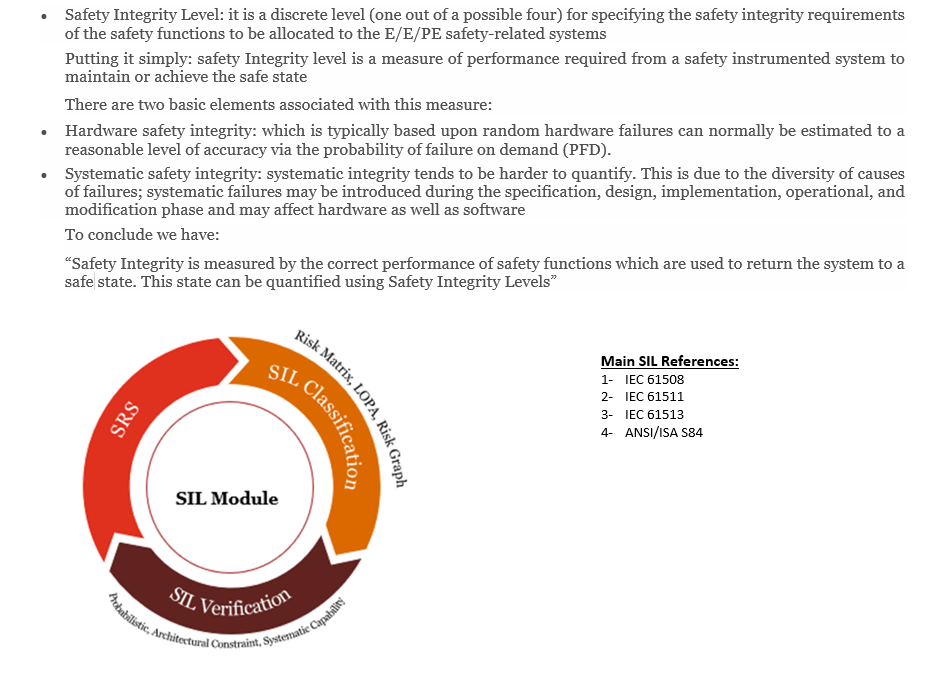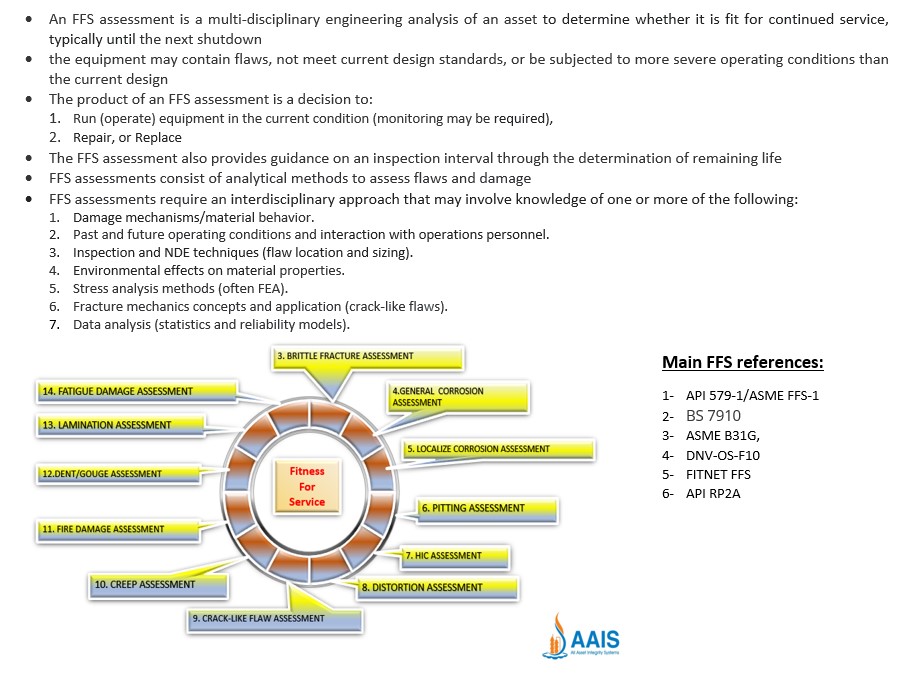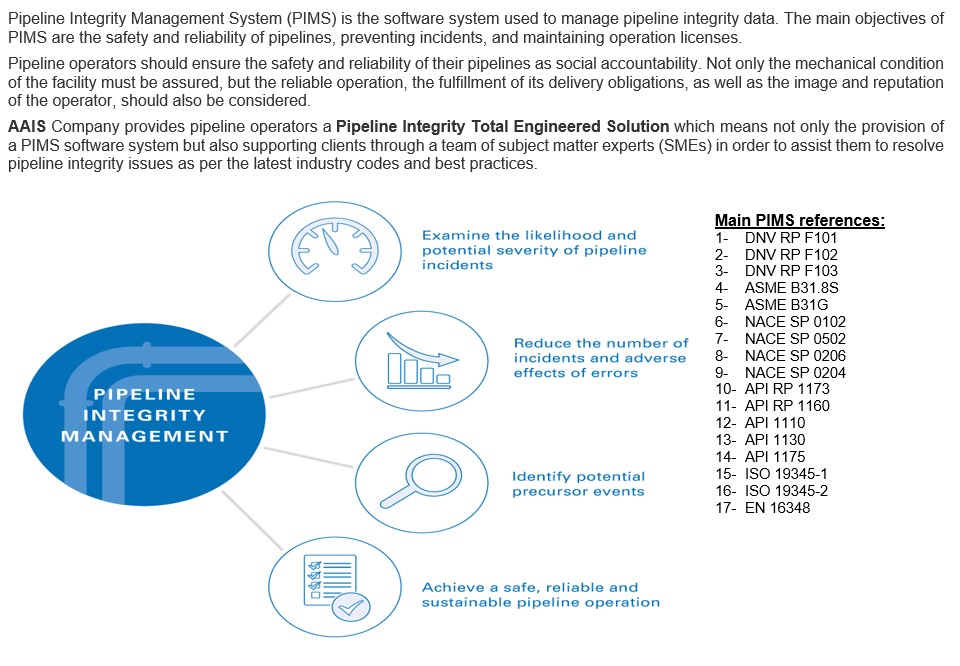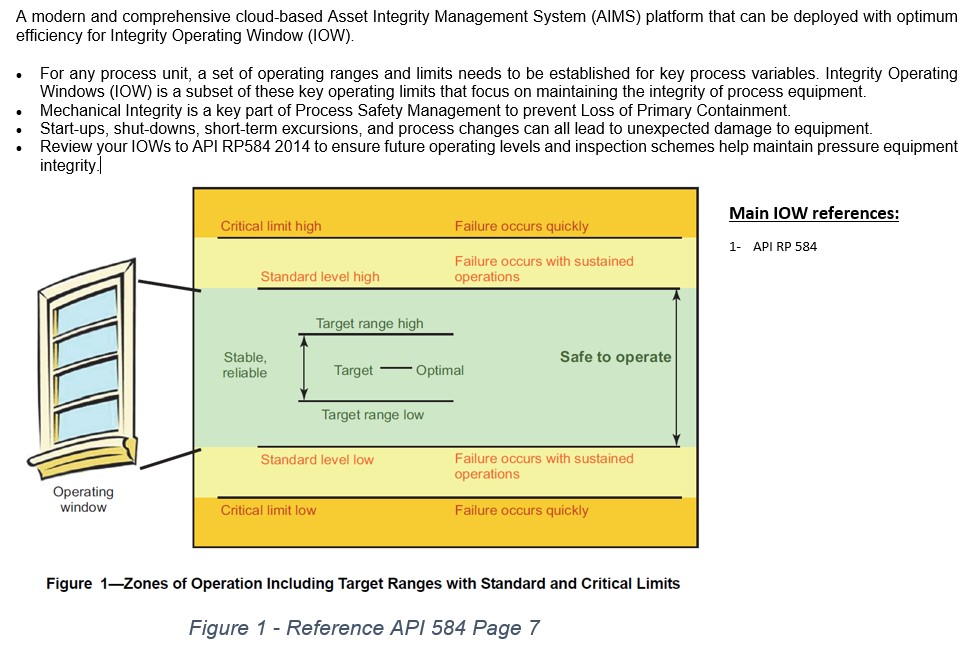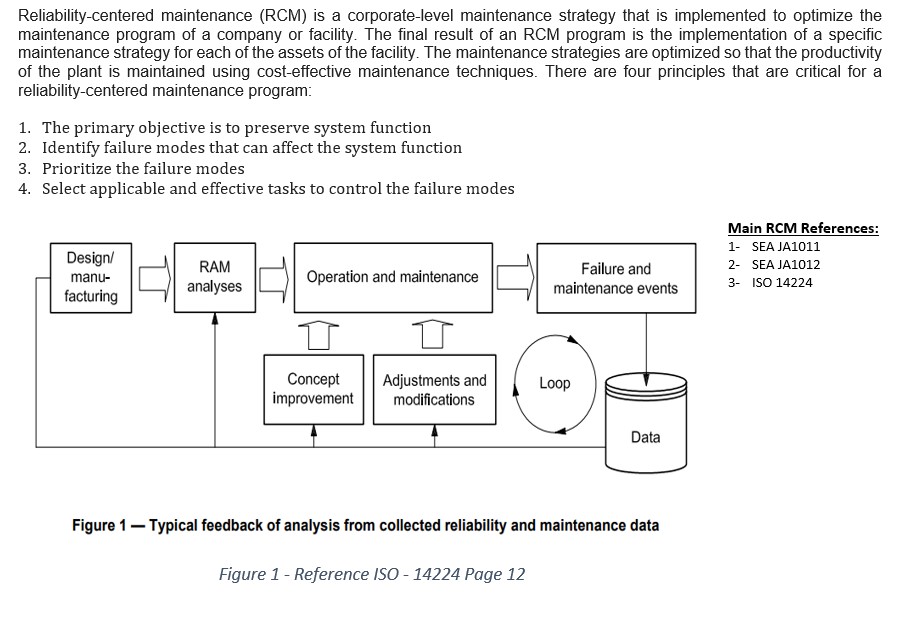Files
|
Type
|
Format
|
Title
|
Edition
|
Description
|
Author
|
Availability
|
Size
|
|---|---|---|---|---|---|---|---|
| Paper | application/pdf |
A Method For Assessing Corrosion In Pipelines And Planning For Intelligent Pigging |
N/A |
A method for assessing the remaining lifetime for corroded pipes is outlined adopting a criterion for required reliability level RP-F 101 gives acceptance criteria for a uniform reliability level of corroded pipelines with different materials, pipe geometries, and defect sizes Different inspection methods with various sizing accuracy are treated. Example applications of the methods are given. Extension of the methods to serve as a tool for the planning of inspection with intelligent pigging is described. |
Mark Marley, Gudfinnur Sigurdsson and Ola Hallvard |
Upon Request |
1,260 KB |
| Paper | application/pdf |
An Overview of the Pipeline Defect Assessment Manual (PDAM) |
2004 |
This paper presents an overview of PDAM (Pipeline Defect Assessment Manual) , and describes some of its novel features. |
Andrew Cosham And Phil Hopkins |
Upon Request |
31 KB |
| S | application/pdf |
API RP 1176 - Recommended Practice for Assessment and Management of Cracking in Pipelines |
2016 |
This recommended practice (RP) is applicable to any pipeline system used to transport hazardous liquid or natural gas. This RP is specifically designed to provide the operator with a description of industry-proven practices in the integrity management of cracks and threats that give rise to cracking mechanisms. |
API |
Upon Request |
2,888 KB |
| RP | application/pdf |
API RP 1183 - Assessment and Management of Pipeline Dents |
2020 |
This Recommended Practice (RP) provides guidance to the pipeline industry for assessing and managing dents present in pipeline systems as a result of mechanical contact by rocks, machinery, or other forces. Emphasis is placed on conditions where dents are either closely aligned or coincident with other threats, and the applicable data screening and assessment methods available to guide decision making on mitigation, remediation, or repair. |
API |
Upon Request |
1,384 KB |
| S | application/pdf |
ASME B31.4-Pipeline Transportation Systems for Liquids and Slurries |
2019 |
This Code also prescribes requirements for the design, materials, construction, assembly, inspection, testing, operation, and maintenance of piping transporting aqueous slurries of nonhazardous materials such as coal, mineral ores, concentrates, and other solid materials, between a slurry processing plant or terminal and a receiving plant or terminal |
ASME |
Upon Request |
2,197 KB |
| S | application/pdf |
ASME B31.8- Gas Transmission and Distribution Piping Systems |
2020 |
ASME B31.8 covers gas transmission and distribution piping systems, including gas pipelines, gas compressor stations, gas metering and regulation stations, gas mains, and service lines up to the outlet of the customer’s meter set assembly. It includes gas transmission and gathering pipelines. This Code prescribes comprehensive solutions for materials, design, fabrication, assembly, erection, testing and inspection. |
ASME |
Upon Request |
5,300 KB |
| S | application/pdf |
ASME B31G-Manual for determining the remaining strength of corroded Pipelines |
2009 |
This document is intended solely for the purpose of providing guidance in the evaluation of metal loss in pressurized pipelines and piping systems. It is applicable to all pipelines and piping systems. |
ASME |
Upon Request |
359 KB |
| Paper | application/pdf |
Assessment and control of topside-riser-pipeline corrosion of a subsea gas re-injection system |
N/A |
This paper describes the approach used to evaluate possible corrosion mechanisms. The scope of the investigation included the following: - Topside re-injection equipment and piping, - Risers - 31-km subsea pipeline from the manned platform to the wellhead injection satellite. The effects of corrective measures are also presented. |
Nguyen Bich And Ed Heaver |
Upon Request |
196 KB |
| Paper | application/pdf |
Assessment of the condition of pipelines as a basis for Economic and Safety-Related optimisation |
2002 |
The following paper outlines the basic features of a system designed for the documentation and assessment of the condition of pipelines. It has to be emphasized, however, that a condition assessment focusing exclusively on the impact of corrosion, although covering an important parameter, is a great deal away from a realistic and comprehensive condition assessment. |
Manfred Veenker , Ulrich Hoffmann, Volker Busack |
Upon Request |
587 KB |
| S | application/pdf |
British Gas - BGC-PS-P11 - Procedures for Inspection and repair of Damaged Steel Pipelines |
1983 |
This British Gas engineering standard defines procedures to be used when dealing with line pipe, used for pipelines and designed to operate at pressures above 7 bar, which has suffered deterioration to parent plate material. |
BGC |
Upon Request |
1,324 KB |
| S | application/pdf |
BS 7910 - Guide to Methods for assessing the acceptability of flaws in metallic structures |
2019 |
This British Standard gives guidance and recommendations for assessing the acceptability of flaws in all types of structures and components. Although emphasis is placed on welded fabrications in ferritic and austenitic steels and aluminium alloys, the procedures can be used for analyzing flaws in structures made from other metallic materials and in non-welded components or structures. The methods described are applicable at the design, fabrication and operational phases of the life of a structure. |
BSI |
Upon Request |
6,555 KB |
| GL | application/pdf |
ClassNK - Guidelines on Pipe Wall Thinning |
2008 |
This Document discusses guidelines on Thickness Reduction (wall thinning) due to flow accelerated corrosion of shipboard piping |
ClassNK |
Upon Request |
101 KB |
| Paper | application/pdf |
Complex corrosion and mechanical damage assessment on pipelines |
N/A |
This document presents how these issues can be addressed using a portable 3D laser scanner and appropriate analysis software. The scanning procedure will be described, followed by the impact of 3D laser technology on data quality, scanning speed and finally, reproducible results. |
Christophe Piron, Jérôme-Alexandre Lavoie, Jérôme Beaumont |
Upon Request |
259 KB |
| S | application/pdf |
DNV- OS-F101-Submarine Pipeline Systems |
2013 |
This standard gives criteria and recommendations on concept development, design, construction, operation and abandonment of Submarine Pipeline Systems. |
DNV |
Free |
2,488 KB |
| RP | application/pdf |
DNV-RP-F108-Fracture Control for Pipeline Installations Methods Introducing cyclic Plastic Strain |
2006 |
This Recommended Practice is developed to give guidance regarding testing and analyses for fracture control of pipeline girth welds subjected to cyclic plastic deformation, e.g. during installation by the reeling method, but also for other situations with large plastic strains. |
DNV |
Free |
148 KB |
| RP | application/pdf |
DNVGL-RP-D101-Structural analysis of piping systems |
2017 |
The objective of this recommended practice is to describe a best practice for how structural analysis of piping systems can be performed in order to safeguard life, property and the environment. It should be useful for piping structural engineers organizing and carrying out the piping design, and any 3rd party involved in the design verification |
DNVGL |
Free |
592 KB |
| Paper | application/pdf |
Ductile Tearing Analysis of a Custom Pipe to Flange Nozzle Using 3D Crack Meshes |
N/A |
The goal of the analysis is to compute the critical crack length that would cause unstable crack growth and structural failure in this piping component. |
Greg Thorwald, And Michael Rock |
Upon Request |
431 KB |
| Paper | application/pdf |
Extending Pipeline Performance |
2000 |
This paper describes the experience of using high resolution internal inspection as a key element of a pipeline integrity strategy to increase pipeline performance. With subsequent Fitness-For-Purpose assessments and remedial action pipeline performance can be increased and the risk reduced and quantified. Examples are presented of strategies for corroding and sour product pipelines, and for uprating. Finally attention is given to repair considerations. |
D G Jones and C L Jones |
Upon Request |
1,458 KB |
| Paper | application/pdf |
FFS - Using 3D Structured Light and Pipeline Integrity |
2013 |
This article will provide the pipeline industry with an understanding of the differences between “screening tools” and “prove up tools,” as well as the benefits of the 3D structured light technology (accuracy, repeatability, reliability and cost), to meet API 579/ASME FFS-1 standards and PHMSA regulations. |
Joe Pikas |
Upon Request |
308 KB |
| Paper | application/pdf |
Finite Element Analysis of the In-service-Welding of T Joint Pipe Connection |
2010 |
In this paper the effects of two major parameters (a) main pipe thickness; and (b)the amount of heat input (electrode diameter) have been investigated on the burn-through risks during the in-service welding of an AISI-316 pipe branch connection on a steam pipeline at full line pressure to perform hot tapping. |
Farid Vakili-Tahami, Mohammad Zehsaz, Mohammad-Ali Saeimi-Sadigh, and Seyedreyhani |
Upon Request |
123 KB |
| Presentation | application/pdf |
Fitness for Service FFS - Local Thin Area in a Line pipe Level 3 |
N/A |
This Presentation gives a general overview on the assessment of local metal loss in line pipe using Level 3 assessment |
Shahab Zangeneh |
Free |
1,797 KB |
| HB | application/pdf |
Fitness-for-Service and Integrity of Piping, Vessels and Tanks |
2005 |
This Book provides instruction on the latest ASME recommended practices for inspecting, evaluating, and monitoring pressure vessels and piping. This handy volume annotates and explains ASME code and API inspection and fitness-for-service practices. Presented in a clear, precise manner, this comprehensive guide meticulously explains how stress analysis, materials, engineering, and nondestructive inspection affect fitness-for-service |
George Antaki |
Upon Request |
35,817 KB |
| HB | application/pdf |
How to Assess Defects in Your Pipelines Using Fitness-For-Purpose Methods |
N/A |
These course notes explain how to conduct fitness-for-purpose assessments of defects in a transmission pipeline, and present a summary of the methods available. The methods cover a wide range of defects, and can be applied to both onshore and offshore oil and gas pipelines. |
Phil Hopkins and Andrew Cosham |
Upon Request |
6,114 KB |
| Paper | application/pdf |
Inspectioneering - Fitness for Service of Damaged Oil Pipeline Using Finite Element Analysis |
2018 |
The purpose of this article is to present an efficient method that combines analytical techniques with FEA to determine the pipeline’s fitness for continued service. |
Dhananjay H. Rawal |
Upon Request |
118 KB |
| Paper | application/pdf |
Inspectioneering - Pioneering Approaches for the Integrity Assessment of Multiphase - Difficult to Pig - Subsea Pipelines |
2015 |
This Paper discusses the approached for the evaluation methods for unpiggable subsea pipelines |
Vibha Zaman and Peter Dsouza |
Upon Request |
500 KB |
| HB | application/pdf |
Introduction to Finite Elements in Engineering |
2002 |
Thoroughly updated with improved pedagogy, this edition of this classic textbook continues to provides a clear and comprehensive introduction the fundamentals of the finite element method. New features include enhanced coverage of introductory topics in the context of simple 1D problems, providing a solid base from which to advance to 2D and 3D problems; expanded coverage of more advanced concepts, to reinforce readers' understanding |
Tirupathi R. Chandrupatla and Ashok D. Belegundu |
Upon Request |
4,249 KB |
| Presentation | application/pdf |
Introduction to the Finite Element Method |
2009 |
This presentation discusses the following topics : - The definition of finite element method - The basic formulation of Finite Element method - Advanced finite element methods |
Sankara J. Subramanian |
Free |
642 KB |
| Paper | application/pdf |
IPC2016-64553 - Effect of Residual Forming Stresses on Fracture in ERW Pipe |
2016 |
This article presents a series of analyses that seek to quantify the magnitude of residual forming stresses as well as their impact on pipeline integrity |
Ted L. Anderson and Gregory W. Brown |
Upon Request |
125 KB |
| Paper | application/pdf |
IPC2016-64563 - A finite element procedure to model the effect of hydrostatic Testing on Subsequent Fatigue Crack Growth |
N/A |
This paper presents a modeling procedure aimed at quantifying fatigue retardation following a hydrostatic test. A series of 3D elastic-plastic finite element simulations have been performed to model fatigue crack growth following a pressure test. The effect of test pressure and MOP on plasticity-induced crack closure was studied. The relative effect of fatigue retardation on remaining life was demonstrated with several examples. In some cases, the results were counter intuitive |
Ted L. Anderson and Greg V. Thorwald |
Upon Request |
393 KB |
| Paper | application/pdf |
Methods For Assessing Corroded Pipeline - Review, Validation and Recommendations |
N/A |
Strengths, weaknesses and limitations of the individual methods are discussed in this paper emphasized that all these methods, especially the Shell-92, PCORRC and BG methods were developed based on the theory of plastic collapse failure and validated against the test results, which generally showed toughness-independent failure behavior |
B Fu, Ashby Road, D Stephens, D Ritchie and C L Jones |
Upon Request |
307 KB |
| Presentation | application/pdf |
Oil and Gas Pipeline Design, Maintenance and Repair - Part 9 - Pipe Defects |
N/A |
This Presentation discusses general defects related to pipelines |
Abdel Alim Hashem El Sayed |
Free |
1,205 KB |
| Paper | application/pdf |
Penspen - A Justification for Designing and Operating Pipelines Up to Stresses of 80% SMYS |
2002 |
This paper summarizes a study to investigate the impact upon safety, reliability and integrity of designing and operating pipelines to stresses up to 80% SMYS (specified minimum yield strength of the pipe material). |
Martin McLamb ,Phil Hopkins, Mark Marley, and Maher Nessim. |
Upon Request |
96 KB |
| Paper | application/pdf |
Penspen - A Method for the Monitoring and Management of Pipeline Risk - A Simple Pipeline Risk Audit (SPRA) |
1999 |
This paper presents a summary of risk management methods used for pipelines. The use of surveillance methods for monitoring population encroachment along pipeline routes is covered. Methods for the assessment of risks associated with pipelines are presented. |
P Hopkins, R Fletcher and R Palmer-Jones |
Upon Request |
118 KB |
| Paper | application/pdf |
Penspen - A New Industry Document Detailing Best Practices in Pipeline Defect Assessment |
2001 |
This paper describes the project, and summarizes some of the best methods currently available for assessing defects in pipelines. |
Andrew Cosham And Phil Hopkins |
Upon Request |
120 KB |
| Paper | application/pdf |
Penspen - A Proposal for the Development of an International RP in Pipeline Defect Assessment and Repair Selection |
2008 |
This manual provides detailed guidance on the assessment of pipeline defects, and is considered to define ‘best practice’. The manual is detailed and is suitable for engineers with experience of pipeline engineering and defect assessment to use. |
Roland Palmer-Jones, Susannah Turner and Phil Hopkins |
Upon Request |
139 KB |
| Paper | application/pdf |
Penspen - A Review of the Time Dependent Behaviour of Line Pipe Steel |
2004 |
In this paper, the results of the small scale and full scale tests and other studies of time dependent behavior are reviewed |
Andrew Cosham, and Phil Hopkins |
Upon Request |
171 KB |
| Paper | application/pdf |
Penspen - Best Practice in Pipeline Defect Assessment |
2000 |
This paper presents fitness-for-purpose methods applicable to the assessment of defects in onshore and offshore transmission pipelines, based on a review of the published literature. Assessment methods for gouges, dents, dents and gouges (external interference defects), corrosion, and girth weld defects are summarized. |
Andrew Cosham, and Mike Kirkwood |
Upon Request |
55 KB |
| Paper | application/pdf |
Penspen - Can Limit States Design be Used to Design a Pipeline Above 80% SMYS |
1998 |
This paper contains the results of a preliminary study, to demonstrate the feasibility of utilizing limit states design procedures for the design of large diameter, onshore pipelines in remote areas |
T.J.E. Zimmerman, A. Cosham, P. Hopkins and N. Sanderson |
Upon Request |
56 KB |
| Paper | application/pdf |
Penspen - Can the Pre-Service Hydrotest be Eliminated |
2000 |
This paper approaches the hydrotest from the structural point of view and asks some fundamental questions: · Why was the hydrotest developed? · What are the advantages and disadvantages? · What are the benefits, perceived or quantifiable? · Have hydrotest failures occurred with regularity? · Have manufacturing, transportation, and construction methods changed to negate the need for a hydrotest? · Are there alternative approaches that can be used to replace the hydrotest without any loss in benefit? |
Mike Kirkwood, and Andrew Cosham |
Upon Request |
54 KB |
| Presentation | application/pdf |
Penspen - Corrosion Rate Assessment |
2009 |
This Presentation discusses the following topics: Corrosion Rate analysis, the corrosion process, Corrosion rate analysis, and applications. |
S. Turner |
Free |
7,251 KB |
| Presentation | application/pdf |
Penspen - How to Assess Corrosion Defects |
2009 |
This Presentation discusses the following topics: Introduction to fracture mechanics, introduction to fatigue, fundamentals of pipeline defect failure, how to assess various damage mechanisms, pipeline smart pigs, and Pipeline repair methods |
Penspen Integrity Ltd |
Free |
15,195 KB |
| Presentation | application/pdf |
Penspen - How to Assess Cracks |
2009 |
This Presentation discusses the following topics: Introduction to fracture mechanics, introduction to fatigue, fundamentals of pipeline defect failure, how to assess various damage mechanisms, pipeline smart pigs, and Pipeline repair methods |
Penspen Integrity Ltd |
Free |
10,491 KB |
| Presentation | application/pdf |
Penspen - How to Assess Dents |
2009 |
This Presentation discusses the following topics: Introduction to fracture mechanics, introduction to fatigue, fundamentals of pipeline defect failure, how to assess various damage mechanisms, pipeline smart pigs, and Pipeline repair methods |
Penspen Integrity Ltd |
Free |
9,954 KB |
| Presentation | application/pdf |
Penspen - How to assess Gouges |
2009 |
This Presentation discusses the following topics: Introduction to fracture mechanics, introduction to fatigue, fundamentals of pipeline defect failure, how to assess various damage mechanisms, pipeline smart pigs, and Pipeline repair methods |
Penspen Integrity Ltd |
Free |
6,544 KB |
| Presentation | application/pdf |
Penspen - How to Assess Weld Defects |
2009 |
This Presentation discusses the following topics: Introduction to fracture mechanics, introduction to fatigue, fundamentals of pipeline defect failure, how to assess various damage mechanisms, pipeline smart pigs, and Pipeline repair methods |
Penspen Integrity Ltd |
Free |
8,632 KB |
| Paper | application/pdf |
Penspen - Inspection & Assessment of Damaged Subsea Pipelines - A Case Study |
2008 |
This paper describes the detailed structural assessment of the damaged pipeline and the inspection and repair operations. |
Richard Espiner, David Kaye , Graham Goodfellow, and Phil Hopkins |
Upon Request |
360 KB |
| Paper | application/pdf |
Penspen - Pipeline Failure - The Roles Played by Corrosion, Flow, and Metallurgy |
N/A |
This paper deals with failure of a pipeline where high quality inspection data together with comprehensive as-built records and stable production conditions allowed the separate influences of flow and metallurgy on corrosion to be studied |
Dominic Paisley, Nathan Barrett, and Owen Wilson |
Upon Request |
78 KB |
| Paper | application/pdf |
Penspen - Pipeline Integrity - Some Lessons Learnt |
2004 |
This paper considers some of the lessons learnt from recent failures and field experiences, and concludes with some guidance for all engineers in the pipeline business. |
Hopkins, P |
Upon Request |
547 KB |
| Paper | application/pdf |
Penspen - Rapid Decision-Making In Emergency Subsea Pipeline Repair |
2011 |
This paper presents a study of a set of large diameters subsea high-pressure gas pipelines supplying an LNG terminal. The damage that might result from an anchor interaction incident with each of the pipelines was modelled, and broad limits for different levels of response were defined. Particular attention was paid to possible damage that could be quickly and efficiently repaired with a grouted clamp system, rather than requiring a complex and expensive cut-out repair. |
Roland Palmer-Jones, Tim Turner, Robin John Glenn, and Aldo Nespeca |
Upon Request |
468 KB |
| Paper | application/pdf |
Penspen - Rehabilitation Options For Internally Corroded Oil Pipelines in a Highly Environmentally Sensitive Area |
N/A |
This paper describes a recent project where the interplay of issues arising from both environmental and engineering factors were examined to reveal the options available to remedy internal corrosion problems within an infield flowlines system well as new-build. |
J.G Downer, R.J Conder, R. Lillie, And R. Dobson |
Upon Request |
190 KB |
| Paper | application/pdf |
Penspen - Repairing Internal Corrosion Defects in Pipelines - A Case Study |
2000 |
This paper discusses the requirements for the safe long-term repair of internal corrosion in oil pipelines, and presents a case study where, following assessment of the corrosion type, a suitable repair was selected and the long-term performance demonstrated. |
Roland Palmer-Jones and Dominic Paisley |
Upon Request |
62 KB |
| Paper | application/pdf |
Penspen - Smart Pigs and Defect Assessment Codes - Completing the Circle |
2004 |
This paper describes how sizing algorithms are constructed and how the quoted tolerances are derived. Probability theory can be used to estimate the likelihood that a defect is smaller or deeper than the reported value. Finally, the effect of defect sizing tolerances and their confidence levels on corrosion growth projections is illustrated, and how they must be taken into account in any defect assessment is emphasized. |
Stephen Westwood and Phil Hopkins |
Upon Request |
390 KB |
| Paper | application/pdf |
Penspen - The Assessment of Corrosion in Pipelines - Guidance in the Pipeline Defect Assessment Manual(PDAM) |
2003 |
In this paper the best practices for the assessment of corrosion in pipelines are presented. Full scale tests, theoretical analyses and assessment methods are also discussed, and the ‘best’ methods included in PDAM (The Pipeline Defect Assessment Manual ) are described. |
Andrew Cosham And Phil Hopkins |
Upon Request |
137 KB |
| Paper | application/pdf |
Penspen - Understanding the Results of an Intelligent Pig Inspection |
N/A |
Intelligent pigs are used extensively for inspecting pipelines. Their use has been increasing rapidly due to their proven benefits, expanding capabilities, and legislative requirements. The result of an intelligent pig inspection is an inspection report with a list of defects. To gain the full benefit from an inspection the pipeline operator must understand the inspection process, and what the list of defects means for the immediate and the future integrity of the pipeline are discussed in this document |
Roland Palmer-Jones, Phil Hopkins, and David Eyre |
Upon Request |
650 KB |
| Paper | application/pdf |
Penspen - Using Quantitative Risk Assessment to Justify Location Class Changes - Case Study |
2012 |
This paper shows how quantitative risk assessment may be used to justify continued safe operation of a pipeline at its original operating stress following a change of class designation, illustrated with a case study from Western Europe |
Paul Rumney and Graham Goodfellow |
Upon Request |
258 KB |
| Paper | application/pdf |
Penspen - When is Corrosion not Corrosion - A Decade of MFL Pipeline Inspection |
2002 |
This paper discusses: -The results and implications of the inspections. -The work performed to demonstrate the continued safe operation of the pipeline. -The results of a physical survey of the pressure-limiting “corrosion” defects. -The possible origins of the ferrous debris layer. -Work that has been done to assess the effect of the debris on the behavior of MFL signals. |
Paul Tims, Owen Wilson |
Upon Request |
723 KB |
| HB | application/pdf |
Piping and Pipeline Assessment Guide |
2006 |
The book is a fitness-for-service guide with emphasis on remediation of piping and pipelines containing flaws. This book is written to be an assessment guide from the plant engineering, pipeline engineering and operations perspective. It is intended to serve as a guide for the practicing plant and pipeline engineer, operations personnel, and central engineering groups in operating companies |
A. Keith Escoe |
Upon Request |
4,673 KB |
| Paper | application/pdf |
The Effect of Dents in Pipelines - Guidance in the Pipeline Defect Assessment Manual |
2003 |
The purpose of this paper is to summarize the toughness limits derived from full scale test data, and describes in more detail the background to the recommendations for the assessment of dents |
Andrew Cosham, And Phil Hopkins |
Upon Request |
44 KB |



